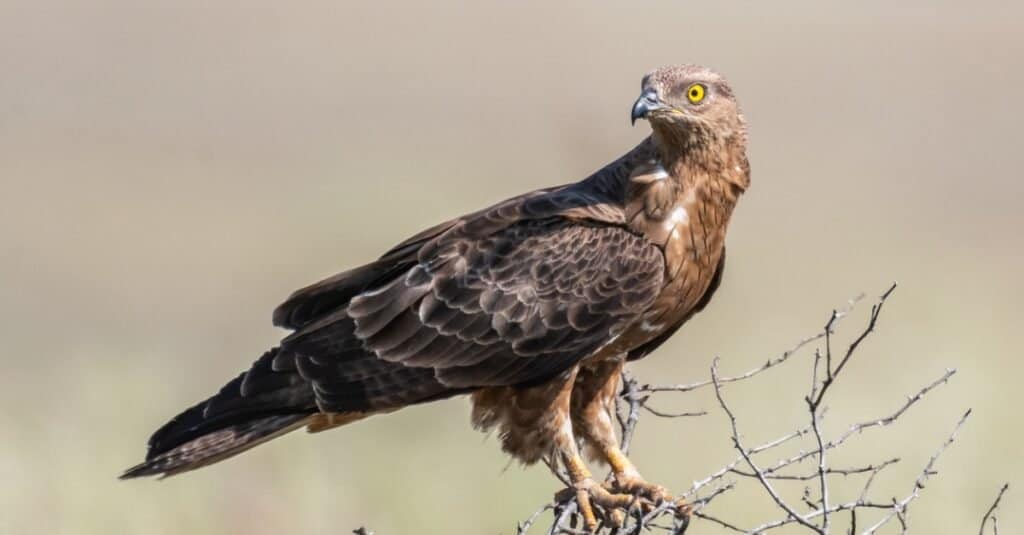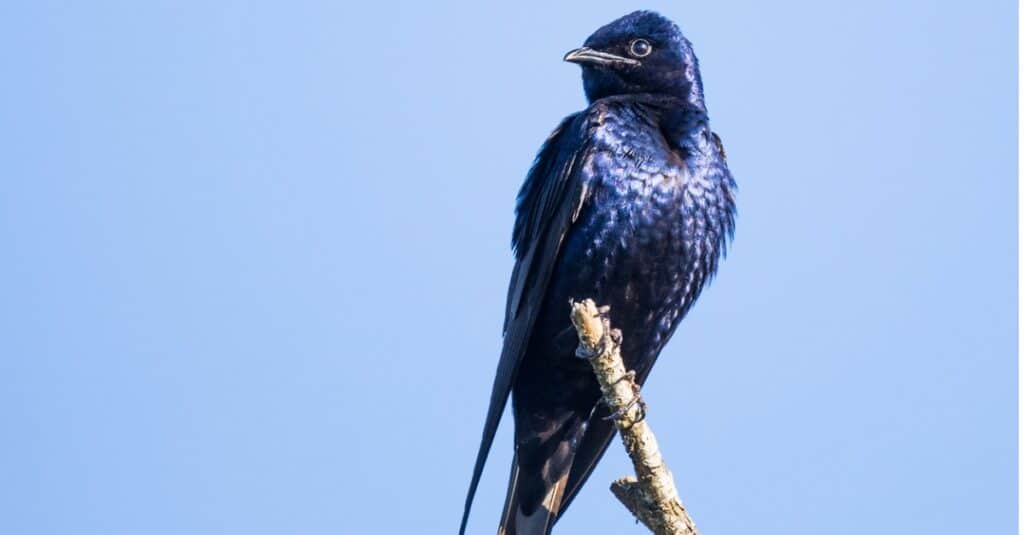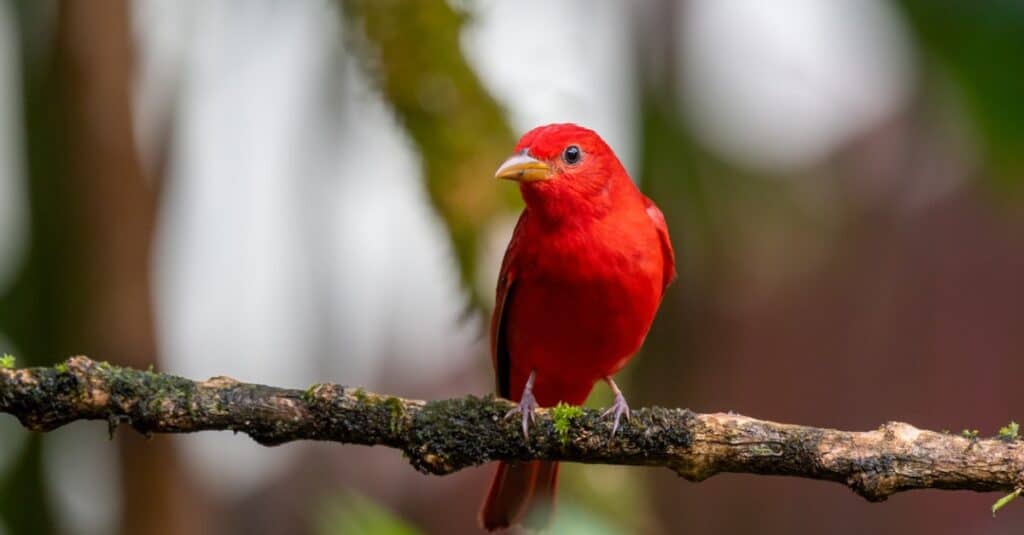Can you imagine eating a bee? While the thought may sound strange, it’s not an uncommon food in some indigenous communities across the globe. In particular, these people target honey bees without stingers and bees still in the larval stage. However, some groups will also target wasps and other types of bees as well. Meanwhile, the consumption of bees is a more common behavior in the animal kingdom, especially among certain types of birds. There are several birds that eat bees, including thrushes, kingbirds, swifts, mockingbirds, and woodpeckers. Woodpeckers especially like to go after the larvae of carpenter bees and leafcutter bees. That said, most of these species rank as only opportunistic bee-eaters. On the other hand, several birds specialize in hunting bees and make them a part of their regular diet. Here are some of those unique birds that eat bees regularly.
#5: Honey Buzzard

The honey buzzard uses its sharp talons to tear apart bee hives and features scaly armor to protect it from stings.
©iStock.com/MriyaWildlife
The honey buzzard is a large bird belonging to the Accipitridae family of hawks, eagles, kites, and vultures. Scientists recognize several different species of honey buzzard, including the European and crested or Oriental honey buzzard. It also goes by the name pern, or the common pern, depending on the region where it lives. Despite its name, it shares more in common with kites than with buzzards in the Buteo genus. The European honey buzzard ranges throughout Central and Northern Europe and Eurasia, and winters in Sub-Saharan Africa. Meanwhile, the crested honey buzzard breeding range extends from China to Japan, and it overwinters in Southeast Asia. A fairly large bird, most specimens typically measure 20 to 24 inches long, with a wingspan 53 to 59 inches long. They typically sport a long tail and short head crest. Usually, they appear light or dark brown with white markings depending on the species.
Honey buzzards are carnivores that eat a wide variety of prey. Common prey includes small insects such as cicadas, small rodents, reptiles, and birds. That said, it is a specialist feeder, and one of the birds that eat bees in large quantities. Specifically, they eat the larvae of wasps, hornets, and bees. It spends the majority of its time hunting for hives throughout the wooded areas that it calls home. Upon encountering a hive, it uses its long talons to break apart the honeycomb and get at the larvae and beeswax inside. Scientists believe that their feathers contain a chemical deterrent that wards off prospective bee attackers. In addition, the feathers on its head and around its eyes are hard and scaly. This adaptation also helps protect them from the stingers of attackers that get past their chemical deterrent.
#4: Northern Cardinal

The northern cardinal will attack and eat bees if a have is nearby, especially during the breeding season.
©Bonnie Taylor Barry/Shutterstock.com
Also known as the redbird, common cardinal, or simply cardinal, the northern cardinal belongs to the Cardinalidae family of songbirds. It’s primarily for its distinctive bright red color and large crest that grows on the head of the males. Northern cardinals are distributed from Canada in the north to Guatemala in the south. In the United States, they range as far as Maine in the east and Texas and Minnesota in the west. That said, introduced populations now also live in some non-native locations including Hawaii and Bermuda. They primarily live in woodlands, gardens, brushy scrubland, and wetland areas. A highly territorial species, males northern cardinals emit a loud, distinctive whistle to let other males know to stay away. Like most songbirds, northern cardinals mate for life. While once a popular pet, the Migratory Bird Treaty act now prevents the trafficking of northern cardinals for sale.
The diet of the northern cardinal is varied and changes depending on the season. In the summer, they primarily eat insects, including flies, beetles, butterflies, crickets, grasshoppers, worms, snails, and slugs. That said, they also enjoy eating bees and will attack a hive and eat the adult bees. In particular, they’re more likely to target a hive during the breeding season when they crave high amounts of protein. During the winter, their diet changes to mostly grains, seeds, fruits, and berries. Given their eclectic diet, cardinals will often pursue the easiest source of food available. Therefore, if a hive of bees is nearby, they will prey upon it, unless they can access a more readily accessible food source such as animal fat suet or a bird feeder.
#3: Purple Martin

The purple martin is an acrobatic hunter, capable of catching bees while in a full dive.
©iStock.com/Jeff Huth
The largest swallow in North America, the purple martin belongs to the Hirundinidae family of swallows, martins, and saw-wings. On average, they grow up to 7.9 inches long with a wingspan up to 16 inches wide. Their breeding range varies, with most purple martins living in the western United States. However, small populations also nest along the Pacific coast, in southern Canada, and parts of Mexico. During the winter, they migrate to South America, with most settling in Brazil, Argentina, Paraguay, Uruguay, and Bolivia. They get their name from their distinctive all-black coloring containing a unique glossy blue sheen. In the right light, this can cause them to look blue or purple. Males and females choose nesting sites together and will build their nests inside cavities in trees or other structures. Unfortunately, their numbers are in decline due to competition for nesting sites from invasive European starlings.
Purple martins enjoy a reputation as agile and acrobatic hunters. They feed by hawking or catching prey in mid-flight. Favorite foods include winged insects such as dragonflies, flies, fire ants, and wasps. However, purple martins also rank among the most prolific birds that eat bees if they can catch them in great quantities. When hawking, they will flap their wings rapidly and make elaborate gliding patterns in order to hone in on their prey. Evidence suggests they may also catch prey while in a dive, which only further highlights their skill as hunters.
#2: Scarlet and Summer Tanager

The summer tanager will rake a bee across the ground to remove its stinger.
©iStock.com/Dave Kempe Photography
The scarlet and summer tanager are both medium-sized songbirds native to North And South America. While formerly classified with the tanager family, Thraupidae, they both now get classified with the cardinal family, Cardinalidae. Summer tanagers breed throughout the central and southern United States and northern Mexico and will winter in South and Central America. Meanwhile, scarlet tanagers primarily live in the northeastern United States and southeastern Canada, and also overwinter in South America. They live in deciduous forests as well as woodland areas nearby suburban neighborhoods and parks. Both species measure a little over 7 inches in length, with a wingspan around 10 to 12 inches long. In appearance, they look very similar to northern cardinals, with bright red feathers on their breasts and backs and darker wings. However, unlike the northern cardinal, they do not feature a black face mask.
While they also eat fruit and berries, scarlet and summer tanagers primarily subsist on flying insects. Common insects in their diet include ants, sawflies, moths, beetles, flies, grasshoppers, dragonflies, and cicadas. That said, they especially target bees and wasps, which make up a large portion of their diet. Upon catching a bee in the air, these tanagers will return back to the same general perch they took off from. This process of going out, catching food, and taking it back to consume it is known as sallying. Upon capturing a bee, wasp, or hornet, a summer tanager will rake the insect across the ground to remove its stinger.
#1: Bee-eater

Bee-eaters can spot a bee up to 330 feet away.
©DimLiya/Shutterstock.com
Of all the birds that eat bees, the ones most known for this behavior are the aptly named bee-eaters. The bee-eaters belong to the family Meropidae, which includes three different genera and 27 distinct species. They range throughout parts of Africa, Europe, Asia, and Australia, although they usually stick to more temperate climates. Every species of bee-eater sports unique, brightly colored plumage with long tail feathers and hooked bills. Bee-eaters build elaborate tunnel networks inside sandbanks and tend to live in groups with dozens or hundreds of members. Males and females mate for life and share parenting duties. Also, some species engage in community parenting, with birds providing childcare for their relatives in the colony.
As their name implies, bee-eaters’ diet primarily consists of bees and wasps. On average, bees and wasps make up 70% of their diet, with the remainder being filled by other flying insects. When hunting, they will wait on a perch until they spot their prey, and then capture their target in midair. Bee-eaters possess impeccable eyesight and some species can spot a bee up to 330 feet away. Once they catch their prey, they will either eat it while flying or return to an open perch. If the bee or wasp is quite large, they will kill it by smashing it on the ground, and then rub it to remove its venom sac and stinger.
The photo featured at the top of this post is © Rob Palmer Photography/Shutterstock.com
Thank you for reading! Have some feedback for us? Contact the AZ Animals editorial team.






